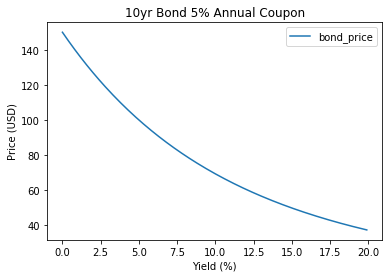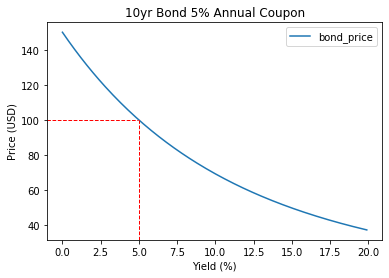Bond prices vs. bond yields
Bond Valuation and Analysis in Python

Joshua Mayhew
Options Trader
Historical government bond yields

Plotting bond prices vs. yields
import numpy as np
import numpy_financial as npf
import pandas as pd
import matplotlib.pyplot as plt
bond_yields = np.arange(0, 20, 0.1)
print(bond_yields)
[0.0 0.1 0.2 0.3 0.4 0.5 0.6 0.7 0.8 0.9 1.0 1.1 1.2 1.3
...
18.5 18.6 18.7 18.8 18.9 19.0 19.1 19.2 19.3 19.4 19.5 19.6 19.7 19.8 19.9]
Plotting bond prices vs. yields
bond = pd.DataFrame(bond_yields, columns=['bond_yield'])
print(bond)
bond_yield
0 0.0
1 0.1
.. ...
198 19.8
199 19.9
[200 rows x 1 columns]
Plotting bond prices vs. yields
bond['bond_price'] = -npf.pv(rate=bond['bond_yield'] / 100, nper=10, pmt=5, fv=100)
print(bond)
bond_yield bond_price
0 0.0 150.000000
1 0.1 148.731575
.. ... ...
198 19.8 37.527719
199 19.9 37.319493
[200 rows x 2 columns]
Plotting bond prices vs. yields
plt.plot(bond['bond_yield'], bond['bond_price'])plt.xlabel('Yield (%)')plt.ylabel('Bond Price (USD)')plt.title("10 Year Bond 5% Annual Coupon")plt.show()

The relationship between price and yield
Prices move inversely to yields
Higher yield = higher discount rate = lower PV
Higher price lowers the return on investment (yield)

The relationship between price and yield
Bond premium vs. bond discount
Premium: Price > 100, Yield < Coupon
Discount: Price < 100, Yield > Coupon
Par: Price = 100, Yield = Coupon

The relationship between price and yield
Price/yield relationship is non-linear
The line we have plotted is not a straight line
This is due to something called convexity

The relationship between price and yield
Summary of key points:
- Prices and yields move inversely
- Premium: Price > 100, Yield < Coupon
- Discount: Price < 100, Yield > Coupon
- Par: Price = 100, Yield = Coupon
- The price/yield relationship is non-linear

Let's practice!
Bond Valuation and Analysis in Python

